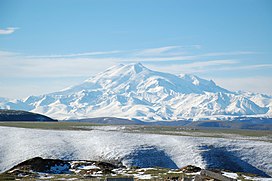Our website is made possible by displaying online advertisements to our visitors.
Please consider supporting us by disabling your ad blocker.
Mount Elbrus
| Mount Elbrus | |
|---|---|
 Mount Elbrus, seen from the north | |
| Highest point | |
| Elevation | 5,642 m (18,510 ft)[1][2][3] |
| Prominence | 4,741 m (15,554 ft) Ranked 10th |
| Listing | Seven Summits Volcanic Seven Summits Country high point Ultra Ribu |
| Coordinates | 43°21′18″N 42°26′21″E / 43.35500°N 42.43917°E |
| Naming | |
| Native name |
|
| Geography | |
| Country | Russia |
| Federal subject | |
| Parent range | Lateral Range Caucasus Mountains |
| Topo map(s) | Elbrus and Upper Baksan Valley by EWP[4][5] |
| Geology | |
| Rock age | Unknown |
| Mountain type | Stratovolcano (dormant) |
| Last eruption | 50 AD ± 50 years[6] |
| Climbing | |
| First ascent | (West summit) 1874, by Florence Crauford Grove, Frederick Gardner, Horace Walker and the guides Peter Knubel and 22 July 1829 by Killar Khashirov |
| Easiest route | Basic snow/ice climb |
Mount Elbrus[a] is the highest mountain in Russia and Europe. It is a dormant stratovolcano rising 5,642 m (18,510 ft) above sea level, and is the highest volcano in the supercontinent of Eurasia, as well as the tenth-most prominent peak in the world.[7] It is situated in the southern Russian republic of Kabardino-Balkaria in the western extension of Ciscaucasia, and is the highest peak of the Caucasus Mountains.
Elbrus has two summits, both of which are dormant volcanic domes. The taller, western summit is 5,642 metres (18,510 ft);[2] the eastern summit is 5,621 metres (18,442 ft). The eastern summit was first ascended on 10 July 1829 by a Circassian man named Khillar Khashirov, and the western summit in 1874 by a British expedition led by F. Crauford Grove and including Frederick Gardner, Horace Walker and the Swiss guide Peter Knubel.[citation needed]
- ^ "Mount Elbrus". The World Book Encyclopedia. World Book, Inc. p. 317.
- ^ a b "Image of the Day: Mt. Elbrus". NASA Earth Observatory. 7 July 2003. Archived from the original on 10 February 2017. Retrieved 15 May 2014.
- ^ "Topographic map of Mount Elbrus". opentopomap.org. Retrieved 14 April 2023.
- ^ "Mount Elbrus Map Sample". EWP. 16 June 2007. Archived from the original on 2 April 2015. Retrieved 15 May 2014.
- ^ "Mount Elbrus and Upper Baksan Valley Map and Guide" (Map). EWP. 1:50,000 with mountaineering information. EWP Map Guides. Cartography by EWP. 2007. ISBN 978-0-906227-95-4. Archived from the original on 24 December 2018. Retrieved 18 April 2008.
- ^ Cite error: The named reference
Smithsonianwas invoked but never defined (see the help page). - ^ "Russia". CIA World Factbook. Central Intelligence Agency. Archived from the original on 9 January 2021. Retrieved 22 February 2016.
Cite error: There are <ref group=lower-alpha> tags or {{efn}} templates on this page, but the references will not show without a {{reflist|group=lower-alpha}} template or {{notelist}} template (see the help page).
Previous Page Next Page







